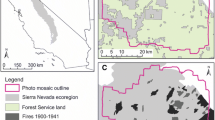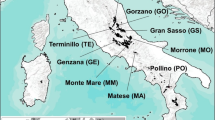Abstract
Five identifiable patterns of deforestation are recognized - internal, indentation, cropping, fragmentation, and removal - and each has a distinct effect on habitat quality of forest patches in the eastern United States. By overlaying land use maps from 1973 and 1981 for three counties in the State of Maryland (Prince Georges, Anne Arundel, and Wicomico), changes in the interior core area and edge length of individual patches were measured. Forest interior declined by 23.8 km2 in Anne Arundel, 16.3 km2 in Prince Georges, and 8.4 km2 in Wicomico. Within Anne Arundel and Prince Georges Counties, deforestation increased edge length by 52.1 km and 31.2 km, respectively, whereas, within Wicomico, it decreased edge length by 8.7 km. Differences among counties resulted from current land use patterns, percentage of forest cover, and the dominant deforestation pattern.
Similar content being viewed by others
References
Ambuel, B. and Temple, S.A. 1983. Area-dependent changes in the bird communities and vegetation of southern Wisconsin forests. Ecology 64: 1057–1068.
Brittingham, M.C. and Temple, S.A. 1983. Have cowbirds caused forest songbirds to decline. BioScience 33: 31–35.
Burgess, R.L. and Sharpe, D.M. (eds.) 1981. Forest Island Dynamics in Man-Dominated Landscapes. Springer-Verlag, New York. 310 pp.
Calhoon, R.E. and Haspel, C. 1989. Urban cat populations compared by season, subhabitat, and supplemental feeding. Journal of Animal Ecology 58: 321–328.
Curtis, J.T. 1956. The modification of mid-latitude grasslands and forests by man. In: Man's Role in Changing the Face of the Earth, pp. 721–736. Edited by W.L. Thomas. University of Chicago Press, Chicago.
Duever, L.C. and Noss, R.F. 1990. A computerized method of priority ranking for natural areas. In: Ecosystem Management: Rare Species and Significant Habitats, pp. 22–33. Edited by R.S. Mitchell, C.J. Sheviak, and D.L. Leopold. New York State Museum Bulletin 471, Albany.
Franklin, J.F. and Forman, R.T.T. 1987. Creating landscape patterns by forest cutting: Ecological consequences and principles. Landscape Ecology 1: 5–18.
Forman, R.T.T., Galli, A.E. and Leck, C.F. 1976. Forest size and avian diversity in New Jersey woodlots with some land use implications. Oecologia 26: 1–8.
Forman, R.T.T. and Godron, M. 1981. Patches and structural components for a landscape ecology. BioScience 31: 733–740.
Forman, R.T.T. and Godron, M. 1986. Landscape Ecology. John Wiley and Sons, New York. 619 pp.
Gates, J.E. and Gysel, L.W. 1978. Avian nest dispersion and fledging success in field-forest ecotones. Ecology 59: 871–883.
Godron, M. and Forman, R.T.T. 1983. Landscape modification and changing ecological characteristics. In: Disturbance and Ecosystems, pp. 12–28. Edited by H.A. Mooney and M. Godron. Springer-Verlag, New York.
Janzen, D.H. 1983. No park is an island: Increase in interference from outside as park size increases. Oikos 41: 402–410.
Leopold, A. 1933. Game Management. Scribners, New York. 481 pp.
Levenson, J.B. 1981. Woodlots as biogeographic islands in southeastern Wisconsin. In: Forest Island Dynamics in Man-Dominated Landscapes, pp. 14–39. Edited by R.L. Burgess and D.M. Sharpe. Springer-Verlag, New York.
Lovejoy, T.E., Bierregaard, R.O., Rylands, A.B., Malcolm, J.R., Quintela, C.E., Harper, L.H., Brown, K.S., Powell, A.H., Powell, G.V.H., Schubart, H.O.R. and Hays, M.B. 1986. Edge and other effects of isolation on Amazon forest fragments. In: Conservation Biology: The Science of Scarcity and Diversity, pp. 257–285. Edited by M.E. Soulé. Sinauer Associated, Inc., Sunderland.
Noss, R.F. 1987a. From plant communities to landscapes in conservation inventories: a look at the Nature Conservancy (USA). Biological Conservation 41: 11–37.
Noss, R.F. 1987b. Protecting natural areas in fragmented Land-scapes. Natural Areas. Journal 7: 2–13.
Noss, R.F. and Harris, L.D. 1986. Nodes, networks, and MUMs: preserving diversity at all scales. Environmental Management 10: 299–309.
Ranney, J.W., Bruner, M.C. and Levenson, J.B. 1981. The importance of edge in the structure and dynamics of forest islands. In: Forest Island Dynamics in Man-Dominated Landscapes, pp. 67–95. Edited by R.L. Burgess and D.M. Sharpe. Springer-Verlag, New York.
Robbins, C.S. 1979. Effect of forest fragmentation on bird populations. In: Management of north central and north-eastern forests for nongame birds, pp. 198–212. USDA Forest Service, North Central Forest Experiment Station, St. Paul, Minnesota. General Technical Report NC-51.
SAF. 1983. Terminology of Forest Science Technology, Practice and Products. Society of American Foresters, Bethesda, Maryland. 370 pp.
Sokal, R.R. and Rohlf, F.J. 1969. Biometry. W.H. Freeman and Comp., San Francisco, California, 776 pp.
Temple, S.A. 1986. Predicting impacts of habitat fragmentation on forest birds: A comparison of two models. In: Wildlife 2000: Modeling Habitat Relationships of Terrestrial Vertebrates, pp. 301–304. Edited by J. Verner, M.L. Morrison, and C.J. Ralph. The University of Wisconsin Press, Madison, Wisconsin.
Turner, M.G. and Ruscher, C.L. 1988. Changes in the spatial patterns of land use in Georgia. Landscape Ecology 1: 241–251.
U.S. Department of Commerce. 1982. 1980 Census of Population: Number of Inhabitants, Part 22, Maryland. Washington, D.C. pp. 22–8.
Wales, B.A. 1972. Vegetation analysis of north and south edges in a mature oak-hickory forest. Ecological Monographs 42: 451–471.
Whitcomb, R.F., Robbins, C.S., Lynch, J.F., Whitcomb, B.L., Klimkiewicz, M.K. and Bystrak, D. 1986. Effects of forest fragmentation on avifauna of the eastern deciduous forest. In: Forest Island Dynamics in Man-Dominated Landscapes, pp. 125–206. Edited by R.L. Burgess and D.M. Sharpe. Springer-Verlag, New York.
Wilcove, D.S., McLellan, C.H. and Dobson, A.P. 1986. Habitat fragmentation in the temperate zone. In: Conservation Biology: The Science of Scarcity and Diversity, pp. 237–256. Edited by M.E. Soulé. Sinauer Associates, Inc., Sunderland.
Wilcox, B.A. and Murphy, D.D. 1985. Conservation strategy: the effects of fragmentation on extinction. American Naturalist 125: 879–887.
Williamson, M. 1975. The design of nature preserves. Nature 256: 519.
Yahner, R.H. 1988. Changes in wildlife communities near edges. Conservation Biology 2: 333–339.
Yaro, R.D., Arendt, R.G., Dodson, H.L. and Brabec, E.A. 1989. Dealing with Changes in the Connecticut River Valley: A Design Manual for Conservation and Development. Lincoln Institute of Land Policy, Cambridge, Massachusetts. 182 pp.
Zipperer, W.C., Burgess, R.L. and Nyland, R.D. 1990. Patterns of deforestation and reforestation in different landscape types in central New York. Forest Ecology and Management 36: 103–117
Author information
Authors and Affiliations
Rights and permissions
About this article
Cite this article
Zipperer, W.C. Deforestation patterns and their effects on forest patches. Landscape Ecol 8, 177–184 (1993). https://doi.org/10.1007/BF00125349
Issue Date:
DOI: https://doi.org/10.1007/BF00125349




